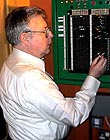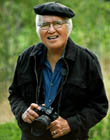|
|
 
|
|
Author
|
Topic: Were there many theatres with a Magnascreen in the early fifties?
|
|
|
Bernard Tonks
Jedi Master Film Handler

Posts: 619
From: Cranleigh, Surrey, England
Registered: Apr 2001
|
 posted 06-22-2003 08:18 AM
posted 06-22-2003 08:18 AM




Claude,
What you may have seen was “THE SNOWS OF KILIMJARO” on an old Magnascope flat wide-screen, which were installed in some of the larger cinemas at the beginning of the 1930s.
Following is from The Complete Projectionist 1943 publication.
Magnascope Effects
A favourite effect in some cinemas is the “Magnascope” or wide-screen effect, in which the width and height of the screen may be increased by 75 per cent. For the presentation of special scenes---large crowds or stage scenes, certain type of shots in the newsreel films, and so on.
This is achieved by the variable focus lens in conjunction with which is used an elaborate system of moving screen masks, all the screen edges moving outwardly on slides, their movement being produced either by hand or motor. If the alteration in lens focus and zoom carefully follows the enlargement of the screen, a very striking effect can be achieved; in certain types of scenes the screen should be opened out when objects are coming towards the camera, and closed when they are moving away from it. These effects, should, however , be used with discretion: the projectionist or manager may become so proud of the device that there is a risk of its being overdone and losing novelty.
I believe that some Magnascope installations did not have variable masking. The screen extended full size within the whole proscenium area.
The cine-variety theatre Regal, Kingston-upon-Thames, where I worked, had a Magnascope screen, which could be lowered from the fly grid in front of the 4 x 3 academy ratio screen, but was only briefly used during the 1930s. In 1953 a proper slightly curved screen frame was installed, which could also be flown for stage shows. The screen was masked full width to a ratio of 1.75. So the flat picture size was over 40 feet wide. Pictures had to be framed so that the titles fitted as best possible, then framed down so that there was no cropping of heads. Within a few months to much relief, pictures were made to allow for wide-screen projection. UK Cinemas advertisements boasted. ON THE GIANT WIDE SCREEN or ON THE GIANT PANORAMIC SCREEN. Until CinemaScope arrived as the new sensation!

| IP: Logged
|
|
Leo Enticknap
Film God

Posts: 7474
From: Loma Linda, CA
Registered: Jul 2000
|
 posted 06-22-2003 12:17 PM
posted 06-22-2003 12:17 PM





Magnascope was one of a number of short-lived widescreen processes from the late '20s/early '30s. As Bernard describes, it was basically a ginormous screen and what was effectively a zoom lens on the projector. Zoom lenses were around in those days but were not used very much because the focus setting could not be changed without taking the lens barrel apart. For camera use these early models (e.g. the Taylor-Hobson 'Varo' of 1932) were really a labour-saving device allowing a sequence of medium-long followed by close-up to be shot without having to physically move the camera around the set. They were never really designed to be 'zoomed' during a shot.
Of course for projection this limitation didn't matter because the screen is always a fixed distance from the projector (unlike the action in a studio shot, which can move in relation to the camera position), hence Magnascope. AFAIK, there were only two Magnascope films which were shown on any significant scale: Chang, from the directors of King Kong, in which the zoom lens is used during scenes of an elephant stampede, and Wings.
Other widescreen systems in use during this period included RKO 'Natural Vision' and Fox Grandeur (both 1929-30). The latter introduced 70mm technology for the first time, and the 70mm Mitchell camera mechanism was dusted down and taken off the shelf two decades later and used virtually unaltered (the only significant modification was to increase the pulldown from four perfs to five) to shoot the first Todd-AO films.
The studios aggressively tried to introduce widescreen on the back of sound in the early '30s, but without success. My theory is that the Wall Street Crash in October 1929 happened at just the wrong time: a huge investment had already been made in equipping studios and theatres for sound and it was too late to back out. But widescreen was still at the prototype stage, and after the crash the venture capital just wasn't forthcoming for a mass-rollout of that as well.
| IP: Logged
|
|
|
|
|
|
|
|
|
|
|
|
All times are Central (GMT -6:00)
|
|
Powered by Infopop Corporation
UBB.classicTM
6.3.1.2
The Film-Tech Forums are designed for various members related to the cinema industry to express their opinions, viewpoints and testimonials on various products, services and events based upon speculation, personal knowledge and factual information through use, therefore all views represented here allow no liability upon the publishers of this web site and the owners of said views assume no liability for any ill will resulting from these postings. The posts made here are for educational as well as entertainment purposes and as such anyone viewing this portion of the website must accept these views as statements of the author of that opinion
and agrees to release the authors from any and all liability.
|

 Home
Home
 Products
Products
 Store
Store
 Forum
Forum
 Warehouse
Warehouse
 Contact Us
Contact Us




 Printer-friendly view of this topic
Printer-friendly view of this topic














